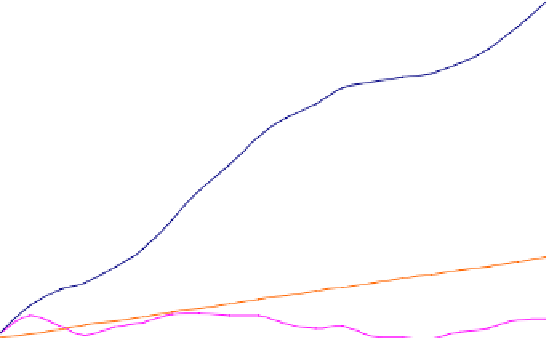Environmental Engineering Reference
In-Depth Information
900,000
800,000
700,000
600,000
500,000
400,000
300,000
200,000
100,000
0
Oct-06
Jan-07
Apr-07
Aug-07
Nov-07
Feb-08
Jun-08
Sep-08
Monthly methane Generation
Cumulative methane
Scholl Canyon
Figure 12. Comparison of Gas Production Data at the Biocell and a Conventional Landfill
For comparison purposes, the Figure 12 includes the cumulative methane generation
curve for a landfill cell containing 43,000 tonnes of waste and operated as a dry-tomb sanitary
landfill. The Scholl Canyon model was used to generate this curve using the parameter
values; k = 0.023 yr
-1
and Lo = 116.7 m
3
/tonne. The parameter values are those proposed by
Environment Canada for a typical sanitary landfill in the province of Alberta. Evidently, the
gas production at the biocell is more than 400% higher than that of a dry tomb type sanitary
landfill of similar size and configuration located in Calgary, Alberta.
2. Biocell stage 2: Aerobic decomposition
Once methane production decreases to a critical level, the next stage of biocell will
initiate, that is to use aerobic degradation to rapidly decompose the remaining organic waste.
Since aerobic degradation occurs at a high rate, this stage may take only a year or two to
complete.
To convert from anaerobic to aerobic conditions, air has to be introduced to the biocell
and maintained to enhance the rate of waste decomposition (Stessel and Murphy, 1992;
Hettiaratchi, 2006). The aerobic bioreactor concept was first proposed by Merz and Stone
(1962) and there are more than 20 operating aerobic bioreactors in North America. The gas
extraction system used during the anaerobic stage will be used to pump air into the landfill to
create aerobic conditions, which accelerates and completes biological degradation or organic
waste. The recirculation of appropriately adjusted leachate for aerobic degradation is also
required for the same reason stated in the first stage of operation. Towards the end of aerobic
decomposition, periodic testing of waste from boreholes and the analysis of the leachate
would ensure complete biodegradation.
The Calgary biocell is not the first to propose the use of aerobic treatment of waste in a
waste cell. Williamson County bioreactor in central Tennessee is one of the existing aerobic




















































